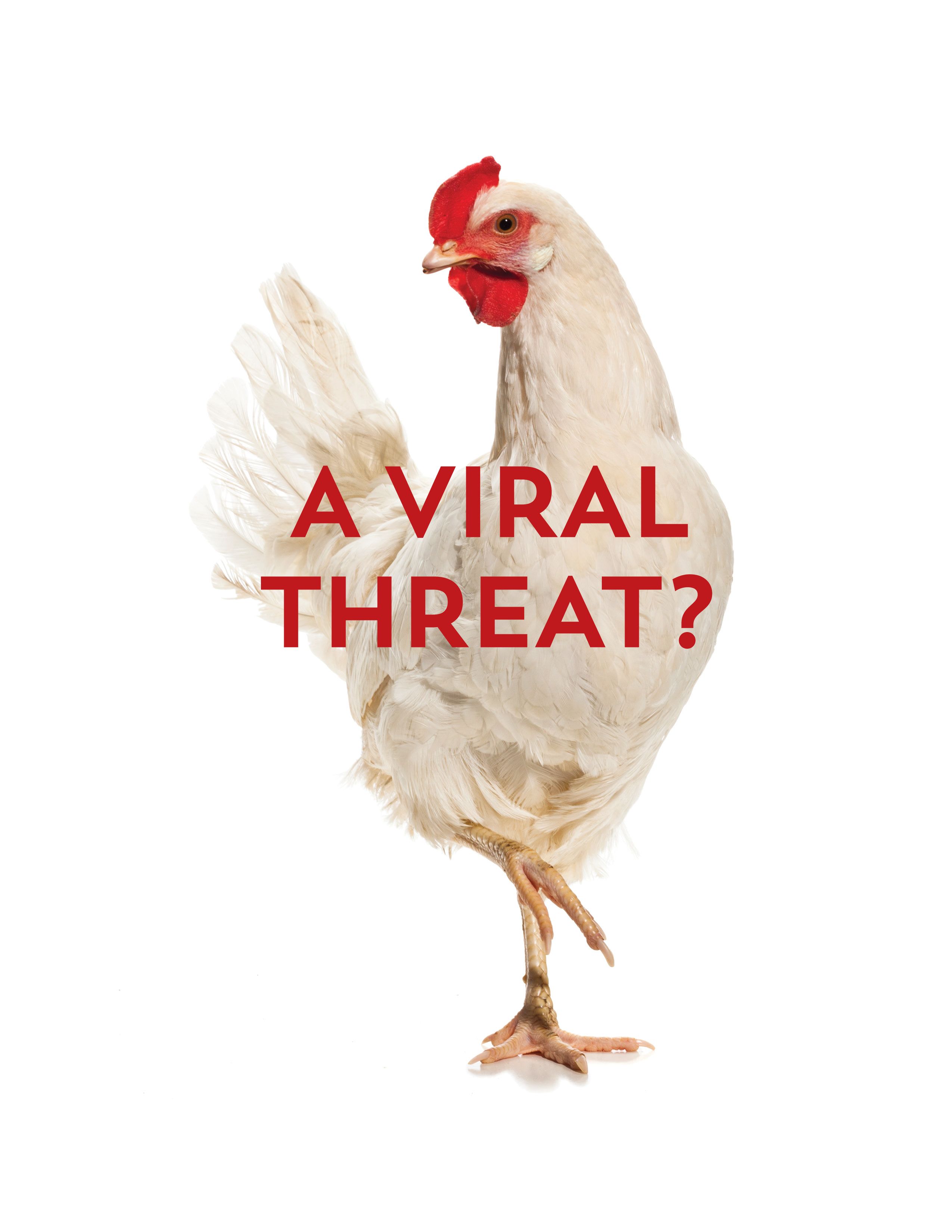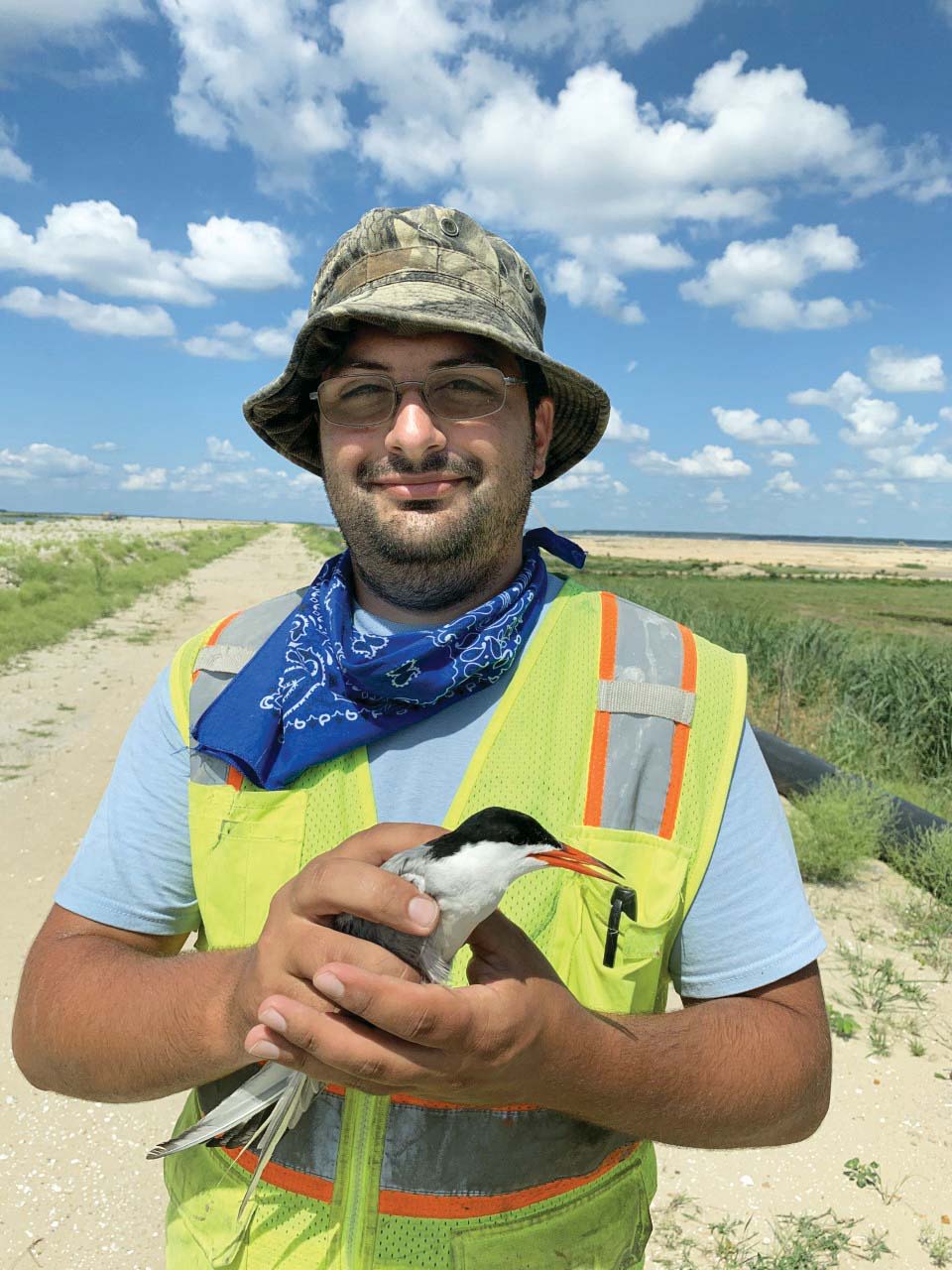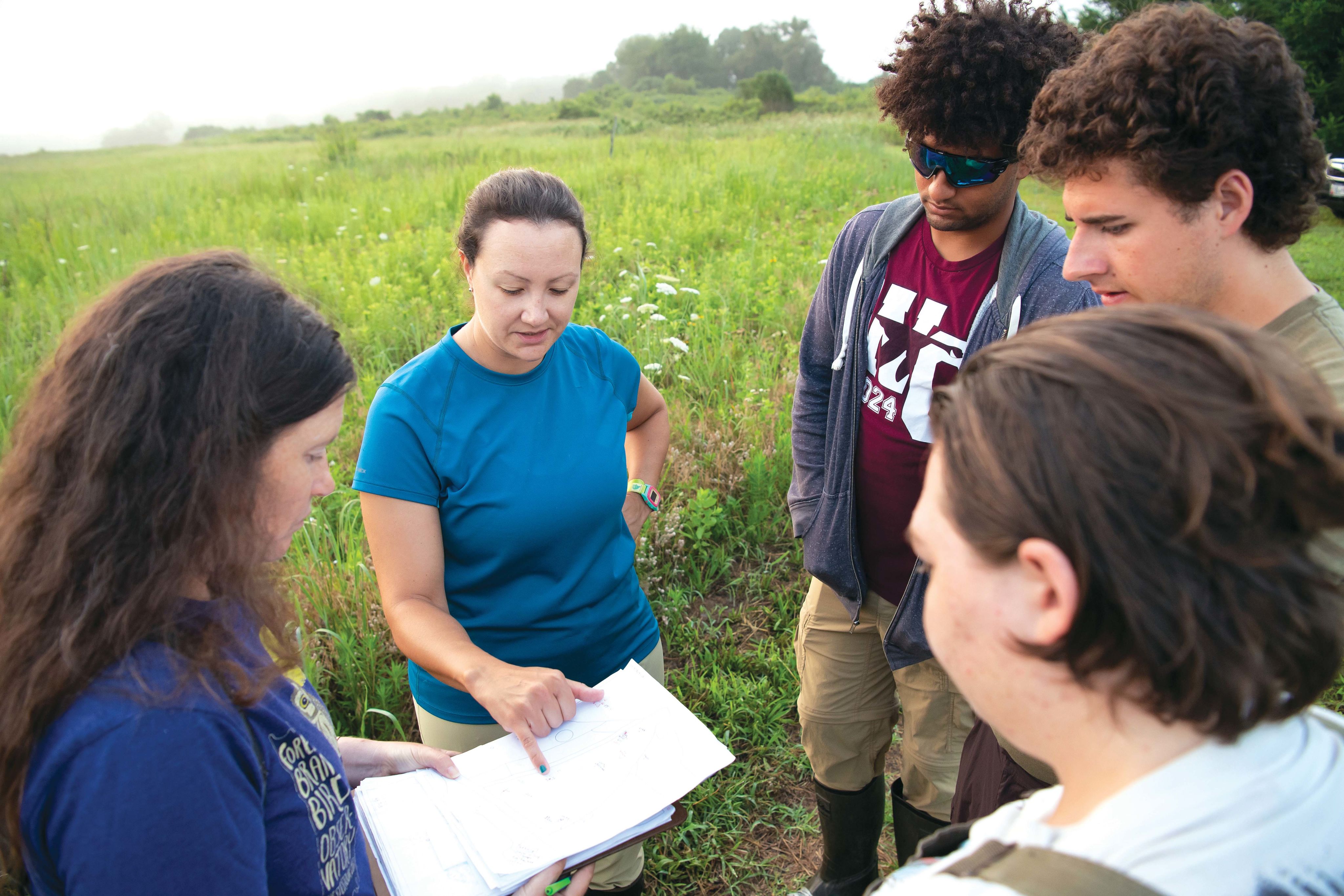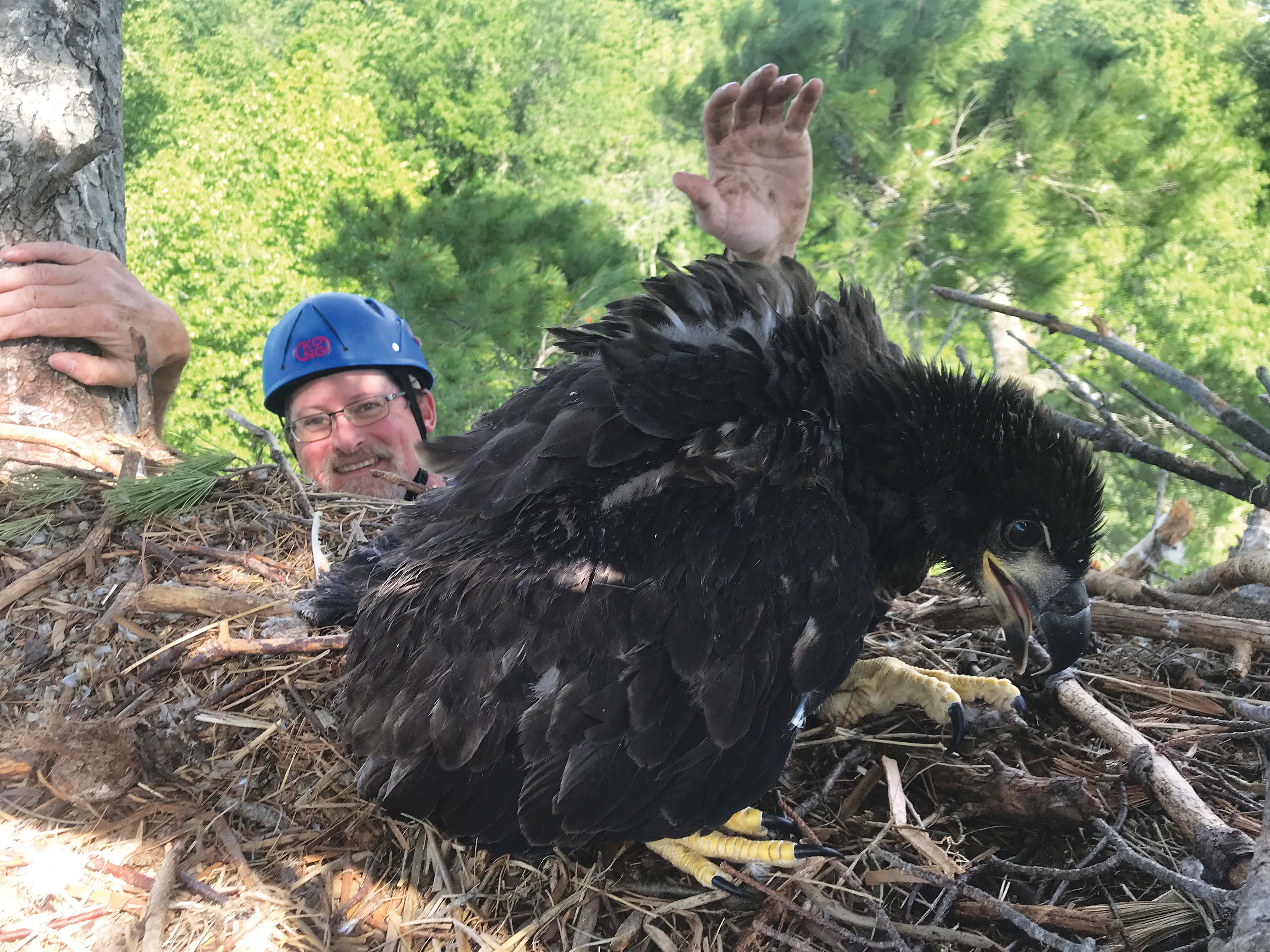Bird flu has caused major mortality events across species around the world. Washington College experts share their insights.
By Darrach Dolan
Bird Flu, specifically the currently circulating H5N1 variant, has killed millions of wild birds and tens of thousands of marine mammals in the last couple of years alone, yet it was not making front-page headlines. The media did report on culls of farmed chickens raising egg prices—100 million chickens have been culled due to bird flu in the U.S. since 2022. A few outlets reported on tourists who couldn’t visit the grave of famous explorer Ernest Shackleton on South Georgia island because the path to his grave was blocked by the decaying corpses of seals killed by H5N1. Mostly, however, the global spread of H5N1 has only been the concern of epidemiologists, virologists, ornithologists, wildlife experts, poultry producers, and the scientists and planners associated with those fields.
That all changed in March when the first cases of H5N1 were discovered in dairy cattle in Texas and Kansas—it has since spread to 93 herds in 12 states and rising. Alarm bells rang because cattle do not typically contract and transmit bird flu, humans have close contact with cattle, and the combination increases the risk of the virus making the leap into the human population. The Centers for Disease Control and Prevention (CDC), United States Department of Agriculture (USDA), and Food and Drug Administration (FDA) have been closely monitoring this development and continuously analyzing virus samples to see if the virus is evolving to be more transmissible in humans. To date, there haven’t been significant human-adapted changes, and the CDC still considers the risk to humans low.
Flu, however, is a perennial threat, with the seasonal flu killing between 20,00 and 50,000 Americans annually. In the 20th century alone, three global pandemics (1918, 1957, 1968) were caused by the flu virus. The most famous and deadly, the 1918 Spanish flu, killed more people than World War I and affected an estimated 20% of the world’s population. Revised estimates of its death toll range from 50 million to 100 million. Analysis of the virus that caused the Spanish flu shows it had several genetic sequences similar to bird flu—in other words, the deadliest flu virus in modern history was a combination of human and bird flu viruses. Could the current H5N1 bird flu virus make a similar leap to a human-adapted virus?
Four Washington College experts—a wildlife biologist, an ecology behaviorist, a raptor expert, and a microbiologist—provide informed perspectives, put the history and recent developments of this globally spreading virus into context, and help quantify the threat to both people and wildlife.

WASHINGTON COLLEGE ALUM ON THE FRONTLINES
Jeff Sullivan ’14 raised livestock as part of the 4-H program, hunted and fished in the lower Delaware with his grandfather, and was always interested in the environment. He chose to attend Washington because of the Chesapeake Semester, where students explore the Chesapeake Bay’s ecology and history, and because the College offered numerous hands-on environmental courses. He majored in environmental studies, minored in biology, and got to study field sparrows and turtles in their natural habitats. After graduating, he completed a master’s at Auburn University, where he studied the ecology of female white-tailed deer as part of his program.
Today, Sullivan is a wildlife biologist for the U.S. Geological Survey (USGS), Eastern Ecological Science Center just outside Washington, D.C., in lead scientist Diann J. Prosser’s laboratory. This lab has two current priorities—to monitor the colonial nesting birds in the Chesapeake Bay region, mostly terns on Poplar Island, and to collect, compile, and analyze data on bird flu. “We focus on everything related to avian influenza and wild waterfowl,” Sullivan said. “How does the virus impact the birds? How do the birds move the virus? How are the birds related to transmission into domestic poultry?”
For the bird flu project, Sullivan goes out into the field to take swabs and blood samples of wild birds, sends collected samples out for analysis, analyzes the data, and co-writes papers on the findings and implications. The swabs are analyzed to see if a bird is actively shedding the flu virus, while the blood samples tell if the bird has developed antibodies to the flu—meaning they have successfully fought off the infection. This data, combined with banding data from around the country, migratory patterns, and studies of the species that are carrying or have been exposed to the virus, paints a bigger picture of the ecology of the virus. This helps federal, state, and local authorities better understand the spread and how to allocate resources. “The importance is kind of twofold,” Sullivan said. “One, understanding the ecology of these species and how that relates to disease threats. Two, understanding the concern of commercial poultry and the likelihood of [virus] introduction events.
“We did get the first telemetry data on an H5 positive bird in North America, a lesser scaup here in Maryland,” Sullivan said. Telemetry data in this context means they had enough data from different sites to map the bird’s migration route. Although it’s not known precisely how the virus spreads from wild birds to domestic poultry, there’s an uptick in poultry infections whenever wild birds with the virus are migrating through an area. These flyway maps can be useful both in tracking the spread of the virus and potentially predicting where it may spread next.
Jeff Sullivan ’14, a biologist with the U.S. Geological Survey, studies bird flu and colonial-nesting birds in the Chesapeake Bay, pictured in the field with a common tern on Poplar Island. Photo Provided by Jeff Sullivan.
Jeff Sullivan ’14, a biologist with the U.S. Geological Survey, studies bird flu and colonial-nesting birds in the Chesapeake Bay, pictured in the field with a common tern on Poplar Island. Photo Provided by Jeff Sullivan.
HIGHLY PATHOGENIC PANZOOTIC
The USGS, among many national and international agencies, is compiling data on bird flu because the planet is experiencing a panzootic caused by highly pathogenic avian influenza (HPAI) H5N1—a panzootic is the equivalent of a pandemic in birds and animals. It’s still primarily a catastrophe for wild and domestic birds, but the CDC reports that it has also affected more than 48 species of mammals and has caused large-scale die-offs (major mortality events) amongst some, including killing more than 70% of the elephant seal pups and an unknown number of adults along the Argentinian coast in 2023.
The first known version of H5N1 was identified in 1996 at a goose farm in China. In 2005, it was detected in wild bird populations after a major mortality event when over 1,000 wild birds died suddenly at a nature reserve in China. Since then, it has been circulating widely and globally for almost 30 years, reaching the periphery of Antarctica this year. Only Australia, New Zealand, and some parts of Polynesia have no documented cases of it in wild birds (Australia is fighting an outbreak of bird flu on poultry farms, but it is not caused by H5N1). The current strain of H5N1 has been circulating in the Americas since 2021 and has caused widespread infections in wild birds, poultry, and animals.
Bird flu viruses are categorized as either low pathogenic or highly pathogenic based on how easily they spread in commercial poultry facilities. Low pathogenic avian influenza (LPAI) is widespread and endemic in certain waterfowl species—not unlike seasonal flu in humans. LPAIs typically cause relatively mild symptoms, are seasonal, and most healthy wild birds recover. Bird flu viruses are categorized as highly pathogenic avian influenza (HPAI) when they infect domestic poultry and spread rapidly through the birds kept in facilities. Obviously, this comes at a high cost to poultry and egg producers. However, historically, HPAIs do not have the same devastating effects on wild birds. HPAI H5N1 is behaving differently.
H5N1 has caused major mortality events in wild birds and has spread to bird species that haven’t been historically exposed to it. For example, it has killed large numbers of common cranes in Israel, 40% of brown pelicans in Peru, and three-quarters of the gannets breeding in Scotland. And in a development that has scientists puzzled, the gannets that survived bird flu infections changed eye color from bright blue to black.
Bird flu also tends to be seasonal, similar to human flu viruses infecting people more in the winter months. H5N1 doesn’t have a clear seasonal profile. Jennie Rinehimer, a Washington College biology professor who specializes in behavioral ecology and uses birds as models, speculated that this aseasonality may contribute to the spread of the virus because it is actively infectious at times of the year when birds flock together for shelter or feeding, whereas other flu variants aren’t active at these times. She thinks it is also possible that this strain is just more virulent and adapted to more species.
“I think with [the virus’] growing virulence and transmission to other types of organisms, that the public should be cognizant of that,” she said. “If people are engaging with wildlife, they should try to mitigate the amount of feeding and congregating that they’re causing those organisms to do.” She thinks people should consider not feeding birds during this outbreak because when birds congregate at feeders it could lead to introducing the virus into new species.
Jennie Rinehimer (center) with Maren Gimpel (left) of Foreman’s Branch Bird Observatory and River and Field Campus interns Eli Bisco-Werner ’24, Grayson Barshick ’24, and Jo Perkins ’24. Photo by Pamela Cowart-Rickman.
Jennie Rinehimer (center) with Maren Gimpel (left) of Foreman’s Branch Bird Observatory and River and Field Campus interns Eli Bisco-Werner ’24, Grayson Barshick ’24, and Jo Perkins ’24. Photo by Pamela Cowart-Rickman.
ANATOMY OF A CHANGING VIRUS
There are four types of flu virus—A, B, C, and D. Seasonal flu in humans is caused by types A and B, with only type A viruses known to have caused pandemics. Bird flu is also a type A virus and is endemic in many sea birds and waterfowl.
Jennifer Wanat, associate professor of biology, explained that subtypes of flu are named after two proteins on the surface of the virus—hemagglutinin (H) and neuraminidase (N). These proteins help the virus bind with receptors on host cells or help the virus break in and out through a cell wall. Humans and birds alike develop immunity to a variant after their immune systems have been exposed to the virus and learned to recognize these proteins as foreign to the body.
“Those two proteins can change over time. And how they are changed influences how the virus gets into a cell and gets back out of a cell,” Wanat said. The flu virus has two ways to change—mutation and reassortment.
Mutations happen naturally in most viruses. When a virus infects a cell, it replicates itself to create more virus. Every time a virus replicates, there is the potential for an error (mutation) in the process. Most of these mutations are bad for the virus and are dead ends. Occasionally, a mutation carries a benefit—it binds to different receptors or confuses the immune system—and these successful variants replicate themselves and may become a dominant strain of the virus. When you have an enormous viral load in multiple species circulating at the same time, such as the current H5N1 panzootic, the chances of one such successful mutation increase exponentially. Wanat said the CDC has been analyzing the genetic profiles of H5N1 samples, including from the infected dairy cattle and farm workers, and sees no significant adaptation to humans from current mutations.
Reassortment is the second way, as Wanat explained it, that the flu virus can change radically overnight. The virus is made up of eight strands of RNA. Think of them as eight strands of molecules side by side and held together by zippers. When they are replicating in a cell, the zippers unzip, each strand floats loose and replicates, then the strands zip back together to make more virus. Sometimes, if two different flu viruses have infected the same cell, the free-floating strands from one virus can zip together with strands from the other virus to produce a very different variant with different properties. Reassortment is a real danger with the current panzootic because so many species have been exposed, increasing the potential for two different viruses to infect at the same time.
Both Sullivan and Wanat identified pigs as a host species of particular concern to the scientific community. “Humans, pigs, and birds all have different receptors that the virus is using to get in, and they have different levels of specificity, and that can influence what the virus can infect,” Wanat said. “Pigs can be infected with more than one type of influenza virus. And if they have a cell that has more than one type of influenza virus in there, those viruses can actually exchange genetic material and could potentially end up with a more pathogenic virus.”
A pig cell could be a Petrie dish where human and bird flu can replicate side by side, increasing the likelihood of a reassortment. There is no certainty this will happen even if pigs are infected with both, but given the viral load in the world and the number of industrial-scale pig farms in the world, it is a real danger. Of course, epidemiologists the world over are aware of this, and governments and international bodies like the World Health Organization (WHO) are actively monitoring the situation.
It’s worth noting that bird flu, although a type A flu virus like many currently circulating human flu viruses, is a bird pathogen structurally different from human flu and poorly adapted to humans. Specifically, the receptors H5N1 binds to are in the upper respiratory system of birds, whereas similar receptors in humans are in the lower respiratory system, making it difficult for bird flu to be transmitted via respiratory droplets in humans.
THE DAIRY FARM DEVELOPMENT
“This particular viral strain has shown decent transfer over into mammals, and the most prominent transfer right now is the transmission into dairy cows,” Sullivan said. “It’s concerning any time you see it cross the avian-mammal border.” According to the CDC, cattle aren’t typically affected by type A flu viruses, however, type D primarily affects cattle but doesn’t cause infection in people or birds.
Concern about the infection of dairy herds appeared to be validated when inactivated traces of the virus were found in over 20% of randomly tested milk in grocery stores, indicating a much wider spread of the virus in dairy herds. Federal and state health officials were quick to reassure the public that the pasteurized milk did not contain the active virus, and the inactivated virus that was found in the milk could not be reactivated in laboratory tests done by the USDA. The same cannot be said for raw/unpasteurized milk. Initial findings indicate that raw milk from infected cows contains high concentrations of live virus—making it unwise to drink raw milk.
In addition to deactivated traces of the virus in pasteurized milk, as of early June, there have been three documented cases of dairy farmworkers being infected. Luckily, the symptoms in all three cases have been mild, and two recovered while the third is recovering. It appears likely that the workers were infected through direct contact with infected milk rather than through respiratory dispersal.
To date, only dairy herds and not beef herds have been infected, and the virus is concentrated in the cows’ udders and their milk. The most compelling hypothesis for the transmission in cattle is that milk residue from an infected cow remains in the milking machines and can infect the next cow hooked up to the machine. Because industrial dairy farms raise calves at centers before sending them to different herds across the country, this might explain how the virus has spread so widely. The good news is that a virus that spreads through direct contact with raw milk is less of a threat to other species and certainly not a transmission method that is likely to cause a pandemic.
The infections of the farm workers also have some positive takeaways. The three workers that we know were infected have had mild symptoms, with conjunctivitis (pink eye) the most common symptom. The latest patient has shown some respiratory symptoms that will need to be monitored, but there has been no human-to-human spread.
In less promising news, cats that drank the raw milk of infected cows also became ill. Half of them died, and the other half had to be humanely euthanized. In a study in the journal Emerging Infectious Diseases, researchers confirmed the cats died of H5N1 infections, had high viral loads in their brains and nervous systems, and showed neurological symptoms prior to death.
SOME REASSURING FACTS
Given how fresh the trauma and disruption of the Covid pandemic is, it would be irresponsible and clinically wrong to claim H5N1 will cause another deadly pandemic.
The Covid virus was new to humans, and human immune systems couldn’t mount the sort of robust defense they do with pathogens they have some previous exposure to. Flu viruses, on the other hand, are old and perennial enemies, and there’s the possibility we may have some immunity from previous encounters with the flu even if this bird flu variant does reassort and change radically. Equally important, we have stockpiles of vaccines and anti-viral medications such as Tamiflu that the CDC and FDA say are likely to be effective against H5N1.
In a breakthrough, researchers at the Perelman School of Medicine at the University of Pennsylvania announced in May that they had successfully created experimental vaccines targeting H5N1 using the mRNA technology they developed to create the first Covid vaccines. The advantage of this technology is that, in the event of people-to-people transmission of the virus, it can produce vaccines rapidly, and they can be customized to target the genetic profiles of emerging strains of the virus.
RAW MILK FROM INFECTED COWS CONTAINS HIGH CONCENTRATIONS OF LIVE VIRUS—MAKING IT UNWISE TO DRINK RAW MILK.
AN EVOLVING AND ONGOING PANZOOTIC
Rinehimer, as a behavioral ecologist, is somewhat conflicted about the virus and its function in nature. In general, she thinks viruses and other challenges to species, like predation or competition for food, are natural parts of the evolutionary dance. These pressures on species drive evolution and sometimes drive weaker or poorly adapted species into extinction. “In the absence of humans,” she said, “extinction is normal. Extinction is a good thing for the long-term health of the biodiversity of our planet.”
With H5N1 she has some reservations. “The problem these days is that humans have had their hands in so many other aspects of nature that we’ve thrown things out of whack so profoundly,” she said. “In my opinion, we have some kind of moral responsibility to right the wrongs.” She thinks we should intervene with species that human actions have driven to the edge of extinction and has some practical advice for people to help birds survive this catastrophe. “The two biggest issues for birds are domestic cats and window collisions, which kill billions every year,” she said. Individuals can make a survival difference to many bird species by taking actions such as not letting cats outside or using readily available remedies to make windows visible to birds.
David Kramar joined Washington College this spring as director of the River and Field Campus. He specializes in natural resource management and has a particular passion for raptors and other birds of prey. He notes that research into bird flu has historically been focused on commercial poultry and natural reservoir species such as waterfowl. “Less well-known is the extent to which avian influenza is found in species that tend to exhibit less communal behavior, such as our raptor populations.”
While working with The Raptor Center at the University of Minnesota, he learned of the infection rates amongst birds of prey. “As of the end of December 2023, the Raptor Center had tested 2,162 individuals with a positive incident rate of 262 individuals, or roughly 12% of all individuals tested,” he said. Infection rates in Maryland, Virginia, and Delaware are less known, and he would like to fill in the data gap. He is in the process of setting up a collaboration between Washington College, the Virginia Department of Wildlife Resources, and the Eastern Ecological Science Center to trap eagles and sample for bird flu. He hopes to have this up and running and start adult trapping over the winter of 2024–25.
David Kramar, director of Washington’s River and Field Campus, climbs to great heights to access a bald eagle nest in Voyageurs National Park, Minnesota. Photo Provided by Dave Kramar.
David Kramar, director of Washington’s River and Field Campus, climbs to great heights to access a bald eagle nest in Voyageurs National Park, Minnesota. Photo Provided by Dave Kramar.
UNCERTAIN TRAJECTORY
What will happen next with H5N1 is uncertain. It looks like it will continue to affect birds and animals globally and spread to new species. “I think our natural populations of animals and plants are really resilient, more so than we give them credit for,” Rinehimer said. Already there are signs of species building immunity to H5N1 and rebounding. The gannets in Scotland are recovering even if their eyes have changed color and they lost a significant percentage of their population. Adelie penguins that were observed dying by the hundreds last year, in the latest study, were found to be foraging and feeding normally despite having antibodies that indicated they had been infected.
Less certain is the outcome for endangered or vulnerable species. In Thailand, 147 tigers in zoos died after eating infected chickens. Cats, both wild and domesticated, appear susceptible to the virus. Given so many wild cats have small and scattered populations, if the virus evolves to spread easily between mammals, it could hasten the extinction of many species. Sea lions, seals, and elephant seals have also suffered major mortality events directly from the virus. Until scientists count the adults and pups during this year’s breeding season, they won’t have a clear picture of how badly the infection in 2023 affected their populations.
Rinehimer is concerned with the bigger picture and how human encroachment on nature is contributing to emerging diseases. “The fact that we are putting ourselves in close proximity with wildlife, we are setting ourselves up to enhance the likelihood of encountering those pathogens,” she said. As for the H5N1 virus, she thinks we need to be vigilant. “It might only be a few mutations away from being highly virulent or becoming of epidemic or pandemic proportions,” she said.



